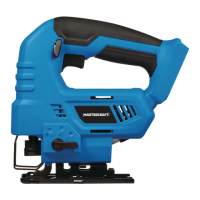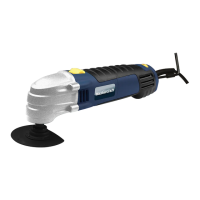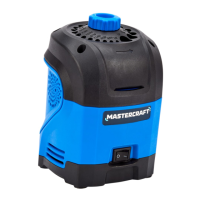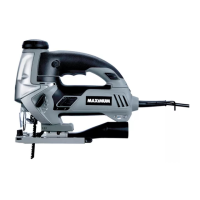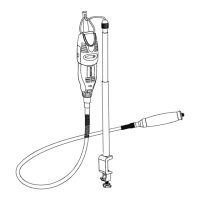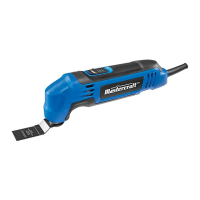headline bars
continuation tabs
notes
warnings
model no. 054-4892-4 | contact us 1-800-689-9928
16
SPEED SETTING (Fig. G)
The tool has a variable speed selector (4) for precise
speed adjustment with number “1” to “6”, the speed
can be adjusted from 8000 to 32000 RPM, the “6”
position is for the highest speed. Continue to dial the
variable speed selector to a higher mark and the speed
will increase accordingly.
Always choose the correct speed range for your work
according to the material. Determine the correct
speed for work on any material by practicing for a few
minutes on a piece of scrap.
Choose a low speed when working with wood, plastics
and polishing, and use the small tools with high speed
and the larger tools with slower speed. When working
with plastic, for example, start with slow speed and
increase the speed until you observe that the plastic is
melting at the point of contact, then reduce the speed
slightly to get the optimum working speed.
RECOMMENDED WORKING SPEED RANGE:
• Plastic and other materials that melt at low
temperatures should be cut with low speed.
• Polishing, buffing and cleaning with a wire brush
should use a medium speed of 15,000 RPM to
prevent damage to the brush and your material.
• Wood should be cut with high speed.
• Cut metal or mild steel with high speed. If a HSS
(high-speed steel) cutter starts with obvious
vibration, it usually indicates that it is running too
slow.
• Aluminum, copper alloys, lead alloys, zinc
alloys and tin should be cut with various speed,
depending on the type of cutting being done. Use
paraffin (not water) or other suitable lubricant on
the cutter to prevent the cut material from adhering to
the cutter teeth.
Fig. A
Collet
Collet nut
Fig. C
Fig. D
a
b
ON
OFF
Fig. E
Fig. F
Fig. G
Fig. H
Fig. I
1/4" (6 mm)
OPERATING INSTRUCTIONS
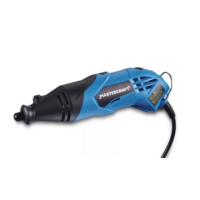
